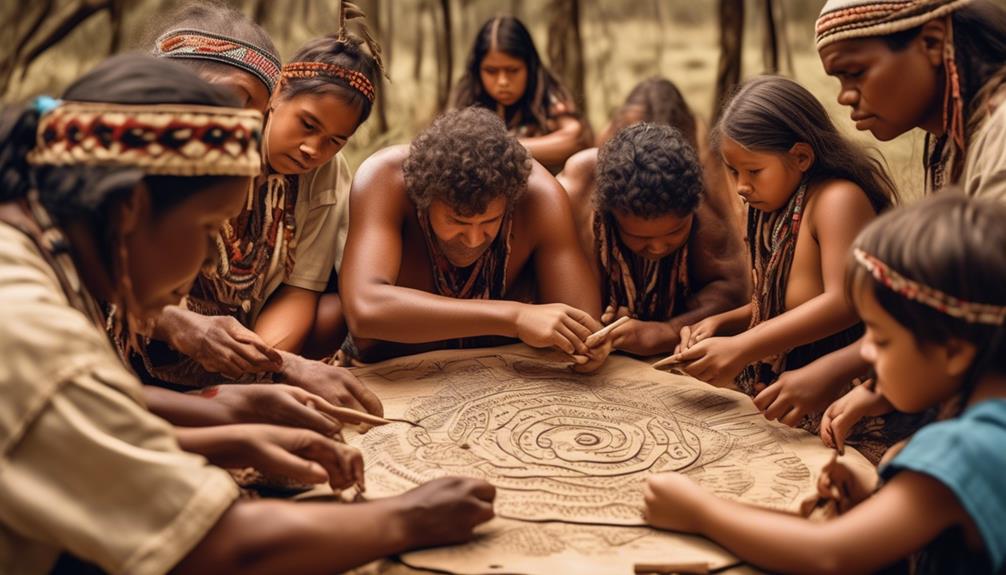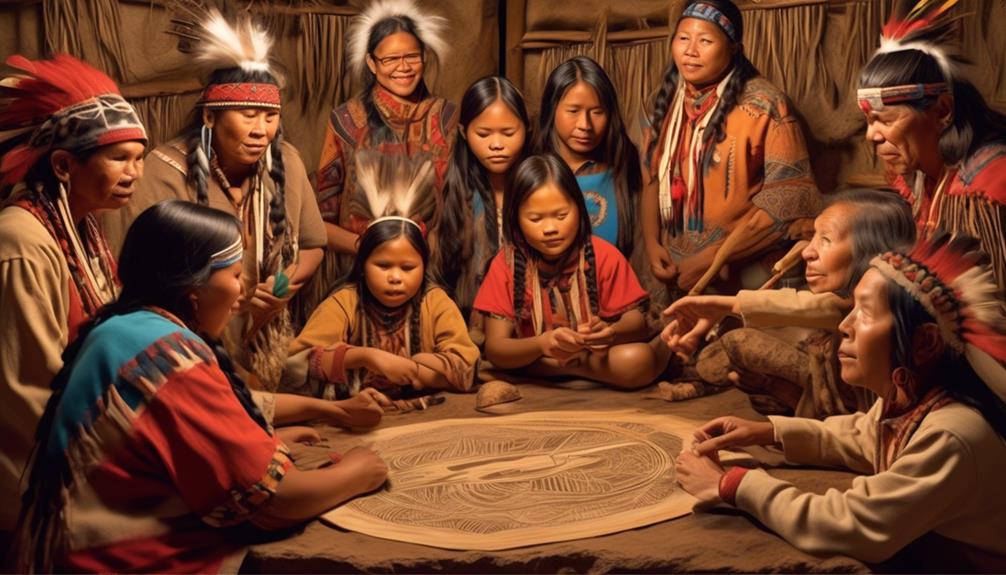I was standing in the midst of a vibrant city center, pondering the various languages and cultures that come together to shape our society.
It's no secret that Indigenous languages are an integral part of our heritage, yet they often struggle to find their place within educational settings. The challenges and opportunities of integrating Indigenous languages into educational curriculums are complex and multifaceted.
From the historical neglect of Indigenous knowledge to the potential for revitalization through innovative initiatives, the journey toward inclusive and culturally responsive education is both daunting and promising.
Let's explore the intricacies of this crucial endeavor and the impact it holds for our diverse communities.
Key Takeaways
- Preserving Indigenous languages is crucial for maintaining cultural identity and diversity.
- Successful language programs can reduce educational disparities and increase community involvement.
- Learning in their mother tongue improves educational outcomes for Indigenous students.
- Indigenous language preservation is essential for the overall well-being of Indigenous communities.
Importance of Indigenous Language Preservation
Preserving Indigenous languages is crucial for maintaining cultural identity and diversity while enhancing educational outcomes and strengthening intergenerational bonds.
Indigenous languages hold profound knowledge about the environment, history, and traditions. When integrated into educational curriculums, they provide invaluable opportunities for Indigenous students to connect with their cultural traditions and heritage. By learning in their mother tongue, students not only gain a deeper understanding of their Indigenous knowledge but also experience improved educational outcomes.
However, the importance of Indigenous language preservation goes beyond individual educational achievements; it's also vital for the overall well-being of Indigenous communities. Successful language programs can reduce educational disparities and increase community involvement, fostering a sense of pride and belonging among Indigenous people.
Nonetheless, this endeavor comes with its challenges, including the need for policies prioritizing Indigenous language education, increased funding, and professional development for teachers. It's essential to recognize the significance of Indigenous language preservation in education and work towards overcoming the obstacles to ensure the continued flourishing of Indigenous languages.
Obstacles to Curriculum Integration

Despite the importance of preserving Indigenous languages in education, numerous obstacles hinder their successful integration into curriculums. Limited resources and materials for teaching Indigenous languages, coupled with a shortage of qualified teachers proficient in these languages, pose significant challenges. Negative attitudes and discrimination towards Indigenous languages further exacerbate the issue, as does the dominance of majority languages in educational systems. The inadequate government support for Indigenous language programs also contributes to the obstacles faced in integrating these languages into curriculums.
| Obstacles to Curriculum Integration |
|---|
| Limited resources and materials for teaching Indigenous languages |
| Shortage of qualified teachers proficient in Indigenous languages |
| Negative attitudes and discrimination towards Indigenous languages |
| Dominance of majority languages in educational systems |
| Inadequate government support for Indigenous language programs |
Addressing these obstacles is crucial for the effective inclusion of Indigenous languages in curricula and teaching methods. Overcoming these challenges will not only promote the preservation of Indigenous languages but also contribute to a more inclusive and diverse education for Indigenous communities. It will also help in the transmission of language and cultural knowledge, fostering the importance of integrating traditional knowledge into modern education systems.
Benefits for Indigenous Students
Understanding the benefits for Indigenous students is essential for promoting the integration of Indigenous languages in education. When Indigenous languages are incorporated into the curriculum, students experience a profound sense of cultural pride and increased self-esteem. This integration also serves as a powerful tool for preserving and transmitting traditional knowledge and cultural practices across generations. As students engage with their traditional language, they develop a stronger connection to their cultural heritage, fostering a sense of belonging and identity within the school environment. Additionally, the use of Indigenous languages in education enhances the overall learning experience for Indigenous students, leading to increased motivation and participation in academic activities.
Moreover, integrating Indigenous languages into educational curriculums promotes community involvement and support for Indigenous students. This inclusive approach not only reduces educational disparities between Indigenous and non-Indigenous students but also fosters a more inclusive and respectful learning environment. By recognizing and incorporating Indigenous knowledges, educational institutions uphold the Rights of Indigenous Peoples and honor the rich cultural diversity within the broader educational framework.
Ultimately, the integration of Indigenous languages in education not only benefits Indigenous students but also contributes to a more equitable and culturally diverse educational landscape.
Implications for the Broader Community

Recognizing the value of Indigenous languages in education not only benefits Indigenous students but also fosters a more inclusive and respectful community environment. Embracing Indigenous languages in educational curriculums presents significant implications for the broader community. By supporting Indigenous language education, the broader community has the opportunity to cultivate greater cultural understanding, appreciation, and respect. This, in turn, can contribute to the preservation and promotion of cultural diversity within our society.
| Implications for the Broader Community |
|---|
| Opportunities |
| Greater cultural understanding and appreciation |
| Preservation and promotion of cultural diversity |
| Stronger connections and collaboration between Indigenous and non-Indigenous community members |
Prioritizing Indigenous language education also has the potential to break down cultural barriers, fostering a more inclusive society. As Indigenous languages are integrated into school curriculums, the broader community can actively participate in and support the preservation of traditional Indigenous knowledge and practices. This, in turn, creates opportunities for the broader community to engage in meaningful dialogue and collaboration with Indigenous peoples. Ultimately, embracing Indigenous languages in education enriches the broader community by promoting diversity, understanding, and inclusivity.
Effective Strategies for Implementation
What are the most effective strategies for implementing Indigenous language education in schools to ensure meaningful and sustainable impact?
To ensure the meaningful and sustainable integration of Indigenous languages into educational curriculums, it's crucial to establish strong partnerships with local Indigenous communities and language speakers. This collaboration enables the development of culturally sustaining curriculum and teaching materials that reflect the traditional languages and cultural knowledge of the community.
Additionally, providing professional development and training for educators is essential for effectively integrating Indigenous languages into the classroom. This equips educators with the necessary skills to incorporate Indigenous language education across various subject areas, promoting holistic and immersive language learning experiences.
Creating opportunities for students to use and practice Indigenous languages through language immersion programs and extracurricular activities further reinforces their language skills. Moreover, fostering a supportive and inclusive school environment that celebrates and respects Indigenous languages and cultures is paramount.
Frequently Asked Questions
What Are the Challenges of Integrating Indigenous Knowledge?
Integrating Indigenous knowledge presents challenges in cultural sensitivity, preservation efforts, linguistic diversity, and community engagement.
Educational resources and language revitalization need historical context and institutional support. Language proficiency requires curriculum development.
These obstacles hinder inclusion.
What Are the Challenges of Indigenous Language?
Preservation efforts for Indigenous languages face significant challenges, including limited resources and negative attitudes.
Cultural sensitivity is crucial, as is government support for language revitalization.
Community engagement and educational resources are essential for curriculum development.
Additionally, teacher training is necessary to ensure proficiency in Indigenous languages.
These efforts are vital for preserving linguistic diversity and maintaining Indigenous identity within educational systems.
What Are the Benefits of Teaching Indigenous Languages?
Teaching indigenous languages brings cultural preservation, identity empowerment, and community connection.
It enhances cognitive development, linguistic heritage, and historical significance.
It fosters intercultural understanding and linguistic diversity while promoting language revitalization.
It also contributes to educational equity and reduces disparities.
These benefits are crucial for our collective well-being and underscore the significance of integrating indigenous languages into educational curriculums.
Why Is It Important to Integrate Indigenous Knowledge in the Classroom?
Integrating indigenous knowledge in the classroom is crucial for cultural preservation, educational equity, and language revitalization. It fosters intergenerational knowledge transfer, community engagement, and identity affirmation.
Embracing linguistic diversity enhances cognitive development and social cohesion. It's vital for decolonizing education and celebrating the rich tapestry of indigenous cultures.
Our commitment to serving others drives us to honor and incorporate these vital traditions into educational curriculums.
Conclusion
In conclusion, integrating Indigenous languages into educational curriculums is crucial for preserving cultural heritage and promoting inclusivity.
Despite the challenges we face, we must embrace the opportunities to revitalize and honor these languages.
It's time to make a change and ensure that all voices are heard and valued in the classroom.
Together, let's break down the barriers and pave the way for a more diverse and interconnected future.
Mary is a passionate writer who brings creativity and a fresh perspective to our team. Her words have the power to captivate and inspire, making her an essential contributor to our content. Mary’s commitment to storytelling and dedication to promoting Indigenous culture ensures that her work touches the hearts of our readers. We’re fortunate to have her as part of our team.










